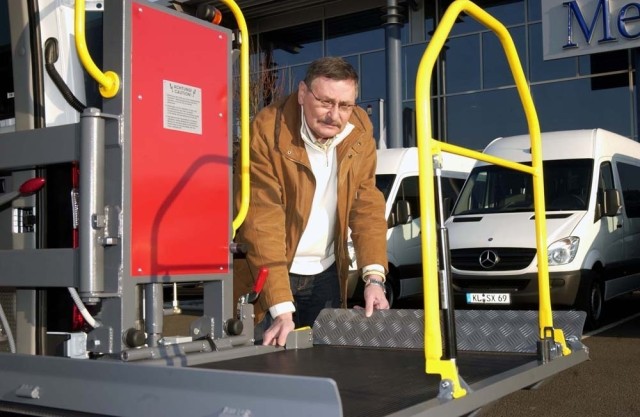KAISERSLAUTERN, Germany (Army News Service, Jan. 9, 2008) - Fourteen Mercedes-Benz vans, outfitted to accommodate wheelchairs, are being distributed this month to Warrior Transition Units throughout Europe.
WTUs are the centerpiece of a new military health system - Army Medical Action Plan - in assisting injured Soldiers as they prepare to return to duty or to transition to civilian life. In 2007, the European Regional Medical Command established WTUs in Germany, Italy and Belgium, where the vehicles will be stationed.
"Mid-January - that's our goal to have all the vans out (to the WTUs)," said Tim Wood, the U.S. Army Garrison Kaiserslautern logistics director.
Each vehicle can accommodate four wheelchairs, with enough room for up to six patients and a medical escort.
Cost for each van is $30,000, with an additional $9,500 for installing a wheelchair lift, railing, flooring and securing system, said Gerhard Heil, the garrison's transportation motor pool manager, who was instrumental in procuring these vehicles for the Installation Management Command-Europe.
The outlay represents a total savings of $120,000 as the Army is leasing and not buying these vehicles, said Heil, adding that the lease runs for a year, with an extension operation.
Leasing, explained Mr. Wood, offers time to ensure the vehicles meet unit transportation needs as well as to study possibly buying more vehicles in the future
The Landstuhl Regional Medical Center logistics branch is contacting each WTU to schedule a time for operators to pick up the vans, which are located at the garrison's motor pool on Daenner Kaserne. The drivers will receive training that focuses mainly on the wheelchair mount and vehicle maintenance.
Originally, these were courier vans already fitted with features "ideally suited for transporting patients," said Mr. Wood. Additions include a high-top roof and aisle lighting - making it easier for medical escorts to check on patients - and an automatic doorstep and movement alarm when the side door is opened.
Another major original feature is "stand heat," which allows for continued warmth even when the vehicle is not running. Windows are also tinted as an added force protection measure.




Social Sharing